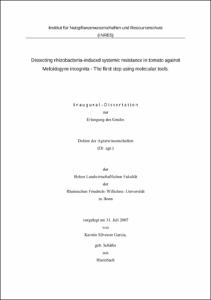Silvestre Garcia, Kerstin: Dissecting rhizobacteria-induced systemic resistance in tomato against Meloidogyne incognita : The first step using molecular tools. - Bonn, 2007. - Dissertation, Rheinische Friedrich-Wilhelms-Universität Bonn.
Online-Ausgabe in bonndoc: https://nbn-resolving.org/urn:nbn:de:hbz:5N-12448
Online-Ausgabe in bonndoc: https://nbn-resolving.org/urn:nbn:de:hbz:5N-12448
@phdthesis{handle:20.500.11811/2735,
urn: https://nbn-resolving.org/urn:nbn:de:hbz:5N-12448,
author = {{Kerstin Silvestre Garcia}},
title = {Dissecting rhizobacteria-induced systemic resistance in tomato against Meloidogyne incognita : The first step using molecular tools},
school = {Rheinische Friedrich-Wilhelms-Universität Bonn},
year = 2007,
note = {Two rhizobacteria with known ability to induce systemic resistance against different soilborne pathogens were studied in split-root experiments for their ability to induce systemic resistance against the root-knot nematode Meloidogyne incognita in tomato. In tomato plants treated with the bacteria strains, Rhizobium etli G12 or Bacillus sphaericus B43, penetrated significantly less juveniles and also reduced the multiplication of the penetrated females after treatment with G12. Results of split-root experiments showed that the penetration of the nematodes was reduced in the responder root, which was the non-bacterial inoculated root, thus confirmed the occurrence of induced systemic resistance (ISR). The bacterial treatment did not affect the root development of tomato plants.
The observed induced systemic resistance was further characterized at the molecular level by subtractive suppressive hybridization using RNA of bacteria treated, bacteria and nematode treated, and untreated tomato plants. The goal was to isolate and characterize plant genes, which were differentially expressed following rhizobacteria-induced systemic resistance.
To obtain only plant RNA without bacteria or nematode RNA contamination a specific split-root set-up was designed. The bacteria as well as the nematodes were applied to the inducer root of the tomato plants and the RNA was extracted from the responder root, which was the non-inoculated root. That ISR was present in the responder root of this set-up was verified by a biocontrol assay, in which nematodes were inoculated at the responder root in a parallel inoculation experiment.
The subtractive suppressive hybridization resulted in the isolation and characterization of 24 potential differentially expressed genes of the induced plants. To confirm the differential expression, different molecular biological analysis methods were used. Northern blotting combined with chemiluminescent or radioactive detection, were not sensitive enough to detect the very small differences in the transcription profile of induced and non-induced tomato plants. The semiquantitative reverse transcriptase PCR showed that the two different bacteria strains induced different reactions in tomato plants. After a G12 treatment the gene coding for the polygalacturonase isoenzyme 1 beta subunit was down-regulated. A B43 treatment or a combined B43 and nematode application up-regulated the gene coding for the phenylalanine ammonia-lyase enzyme (PAL5). These findings exemplify the complexity of rhizobacteria-induced systemic resistance against Meloidogyne incognita.},
url = {https://hdl.handle.net/20.500.11811/2735}
}
urn: https://nbn-resolving.org/urn:nbn:de:hbz:5N-12448,
author = {{Kerstin Silvestre Garcia}},
title = {Dissecting rhizobacteria-induced systemic resistance in tomato against Meloidogyne incognita : The first step using molecular tools},
school = {Rheinische Friedrich-Wilhelms-Universität Bonn},
year = 2007,
note = {Two rhizobacteria with known ability to induce systemic resistance against different soilborne pathogens were studied in split-root experiments for their ability to induce systemic resistance against the root-knot nematode Meloidogyne incognita in tomato. In tomato plants treated with the bacteria strains, Rhizobium etli G12 or Bacillus sphaericus B43, penetrated significantly less juveniles and also reduced the multiplication of the penetrated females after treatment with G12. Results of split-root experiments showed that the penetration of the nematodes was reduced in the responder root, which was the non-bacterial inoculated root, thus confirmed the occurrence of induced systemic resistance (ISR). The bacterial treatment did not affect the root development of tomato plants.
The observed induced systemic resistance was further characterized at the molecular level by subtractive suppressive hybridization using RNA of bacteria treated, bacteria and nematode treated, and untreated tomato plants. The goal was to isolate and characterize plant genes, which were differentially expressed following rhizobacteria-induced systemic resistance.
To obtain only plant RNA without bacteria or nematode RNA contamination a specific split-root set-up was designed. The bacteria as well as the nematodes were applied to the inducer root of the tomato plants and the RNA was extracted from the responder root, which was the non-inoculated root. That ISR was present in the responder root of this set-up was verified by a biocontrol assay, in which nematodes were inoculated at the responder root in a parallel inoculation experiment.
The subtractive suppressive hybridization resulted in the isolation and characterization of 24 potential differentially expressed genes of the induced plants. To confirm the differential expression, different molecular biological analysis methods were used. Northern blotting combined with chemiluminescent or radioactive detection, were not sensitive enough to detect the very small differences in the transcription profile of induced and non-induced tomato plants. The semiquantitative reverse transcriptase PCR showed that the two different bacteria strains induced different reactions in tomato plants. After a G12 treatment the gene coding for the polygalacturonase isoenzyme 1 beta subunit was down-regulated. A B43 treatment or a combined B43 and nematode application up-regulated the gene coding for the phenylalanine ammonia-lyase enzyme (PAL5). These findings exemplify the complexity of rhizobacteria-induced systemic resistance against Meloidogyne incognita.},
url = {https://hdl.handle.net/20.500.11811/2735}
}






